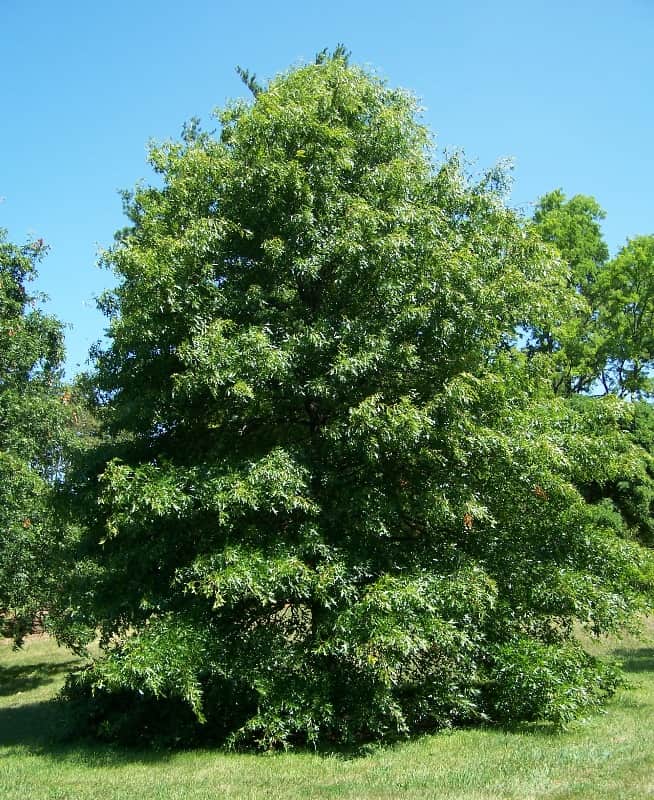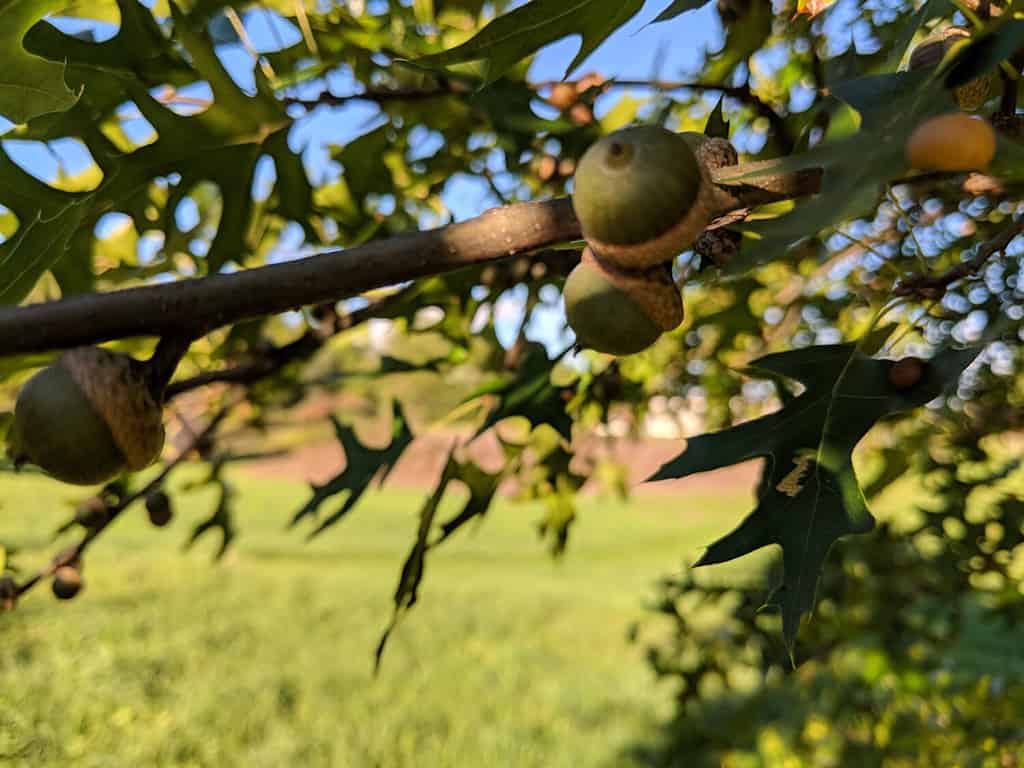Live oaks and Water oaks are very common trees in the southeastern U.S. and are both a sight to see. But, they’re two very different trees with distinct features and qualities.
Whether you want to learn about these trees to identify them in parks or are considering one for landscaping — since they’re both great shade trees — keep reading to find out how to tell one from the other.
About Live Oaks
Live oaks (Quercus virginiana) are incredible and iconic southern oak trees, with a huge spread and a strong presence. Live oaks are often grown as landscaping for homes or parks, since they’re so large and provide tons of shade.
These oaks are evergreen trees that are native to the southeastern U.S., which is why they’re sometimes called Coast Live Oak. They grow in USDA zones 8 through 10, although they can often live even further south at the tips of Florida or Texas.
About Water Oaks
Water oak (Quercus nigra) is a deciduous tree that is also native to the southeast but grows in zones 6 to 9. This means it doesn’t grow as far south and has a much stronger colder tolerance, as it can grow in many states north of the coast.
Water oaks prefer well-draining and moist soil, so they’re often found growing along streams or river beds, which is how they got their name. However, these trees are also sometimes called Pin Oak, which is a general name that applies to many types of oak trees.
Live Oak vs. Water Oak at a Glance
| Live Oak | Water Oak | |
|---|---|---|
| Height | 50-80 feet tall | 80-90 feet tall |
| Shape | Widespread | Conical |
| Lifespan | 200-250 years | 50-70 years |
| Bark | Dark brown | Light brown or gray |
| Leaves | Dark green, oval-shaped | Light, oblong |
Appearance
The clearest distinction between these two types of oaks is their look. Live oaks have a very distinct look that water oaks share no similarity with.
Live oaks have a huge spread that’s often twice the height of the tree, with large branches that spread out and eventually droop down, sometimes even reaching the ground! Live oaks are typically between 50 and 60 feet tall, however, they’ll grow to 80 feet at full maturity.
Live oaks have an outward growth habit, so their branches spread wide, often upwards of 100 feet. Their branches are thick with deep bends that form an irregular crown.
On the other hand, water oaks grow in almost the opposite form. Water oaks are tall and grow vertically, with a trunk that’s only 3 feet wide and a cone-shaped crown that fills out as the tree matures. These oaks are also much taller, often growing over 80 feet tall.

©iStock.com/WerksMedia
Lifespan
Although it’s not as obvious, lifespan is another huge difference between these trees, since live oaks live almost three times as long. Most live oaks live for around 200 years, some even 250!
This is partially because their horizontal growth makes their crown stronger and increases tolerance to intense coastal storms with high winds. Water oaks, however, are not so aerodynamic.
While water oaks live for a maximum of 100 years, they don’t often live that long since they’re highly susceptible to rotting and trunk diseases. Because they’re so tall, water oaks often suffer from wind damage, which exposes their inner wood to bacteria that cause the trunk to rot from the inside out.
Because of this vulnerability, these trees often only live to 50 years, sometimes reaching 60 or 70.
Bark
Bark color and texture are other easy indicators to determine if a tree is a live oak or water oak.
Live oaks have rough, dark brown bark with many cracks that turn into deep fissures on older branches. Water oaks have lighter, almost gray bark that’s very scaly, but smoothes out into large plates over time.
Root System
Both live oaks and water oaks have a shallow root system, meaning that their roots are spread over and just below the surface of the ground.
Because live oaks are such heavy trees, and they live for so long, their roots are also very thick and dense. The root system of a live oak can be just as widespread as its crown since its roots have to keep such a huge tree firmly planted. This can sometimes be problematic given the roots are so shallow and can crack concrete on the surface.
The root system for water oaks is shallow but not nearly as thick or large as live oaks’. Water oaks are also very heavy feeders, which means that their roots pull in lots of nutrients from the soil, sometimes detracting from plants around them.

©Bruce Marlin / CC BY-SA 2.5 – License
Wood Usage
You can imagine that a tree as large and strong as a live oak has really durable wood, but did you know that live oak wood has been used for centuries for shipbuilding? Because the branches have such huge curves, they’re perfect for shaping the curve of boats. Although, live oak wood is used for several things, like furniture, firewood, and large posts, for example.
Water oak wood isn’t as strong, so it doesn’t have such a wide range of uses, but there are a few uses such as fence posts or firewood.
Both of these trees are loved for their large canopies that provide lots of shade, which is a great reason to keep them alive!
Leaves
Live oaks have dark green, oval-shaped leaves that grow along the same stems, alternating on either side. Water oaks have lighter green leaves that are oblong, rounding out at the bottom. Both trees drop their leaves in the fall when temperatures get lower.
Minor Differences
Two more small differences to note are the nuts and flowers of each tree.
Both live oaks and water oaks produce an acorn that looks similar and ripens in the fall, but the live oak acorn falls out of its cap when it drops, while the water oak acorn falls with its cap.
For both the live oak and water oak, male and female flowers bloom in spring on the same tree. They both have catkin male flowers, which look like long, droopy flowers. However, the female flowers are different on each tree — single, open blooms on live oaks and small clusters of flowers on water oaks.
Are Water Oaks Messy?

Water oaks have a reputation for being messy trees.
©Emily Nestlerode/Shutterstock.com
Yes, water oaks are known to be quite messy. The reason is that once they reach the age of about 20, these trees produce large amounts of acorns annually. Because they start to decline in health around the age of 50, they are susceptible to weather like heavy rain, snow, or frost, causing them to lose limbs. And as rot sets in, cavities can form in their trunks. In warmer southern regions, water oaks lose their leaves in winter, requiring a lot of raking to clear the dead foliage.
Two Very Unique Trees
As you can see, live oaks and water oaks have a lot of differences and don’t have much in common other than being southern oaks. This should make it easier to identify one from the other when you see them. Hopefully, if you’re planning to start growing one for your landscaping, all this information can help you decide which is best for you!
The photo featured at the top of this post is © iStock.com/Sunshower Shots
Sources
- Texas A&M University, Available here: http://texastreeid.tamu.edu/content/listOfTrees/index.aspx?t=O
- Above and Beyond Tree, Available here: https://www.aboveandbeyondtree.com/tree-services-blog/how-to-identify-the-difference-between-live-oaks-and-water-oaks#:~:text=Live%20oaks%20have%20evergreen%20leaves,four%20(4)%20inches%20long
- Helen Mitternight, Available here: https://www.postandcourier.com/features/home_and_garden/all-oaks-arent-angels-water-oaks-as-common-as-live-oaks-but-not-nearly-as/article_d3c67c28-b0f5-11e6-9ed6-5b2ce9cb1ab6.html
Thank you for reading! Have some feedback for us? Contact the AZ Animals editorial team.






